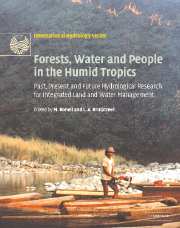 Forests, Water and People in the Humid Tropics
Forests, Water and People in the Humid Tropics Book contents
- Frontmatter
- Contents
- List of contributors
- Foreword
- Preface
- Acknowledgements
- Symposium and Workshop
- Introduction
- Part I Current trends and perspectives on people–land use–water issues
- Part II Hydrological processes in undisturbed forests
- Part III Forest disturbance, conversion and recovery
- Part IV New methods for evaluating effects of land-use change
- 27 Remote sensing tools in tropical forest hydrology: new sensors
- 28 Detecting change in river flow series
- 29 How to choose an appropriate catchment model
- 30 The disaggregation of monthly streamflow for ungauged sub-catchments of a gauged irrigated catchment in northern Thailand
- 31 Parsimonious spatial representation of tropical soils within dynamic rainfall—runoff models
- 32 Isotope tracers in catchment hydrology in the humid tropics
- 33 Process-based erosion modelling: promises and progress
- 34 Impacts of forest conversion on the ecology of streams in the humid tropics
- Part V Critical appraisals of best management practices
- Conclusion: Forests, water and people in the humid tropics: an emerging view
- Plate section
- References
31 - Parsimonious spatial representation of tropical soils within dynamic rainfall—runoff models
from Part IV - New methods for evaluating effects of land-use change
Published online by Cambridge University Press: 12 January 2010
- Frontmatter
- Contents
- List of contributors
- Foreword
- Preface
- Acknowledgements
- Symposium and Workshop
- Introduction
- Part I Current trends and perspectives on people–land use–water issues
- Part II Hydrological processes in undisturbed forests
- Part III Forest disturbance, conversion and recovery
- Part IV New methods for evaluating effects of land-use change
- 27 Remote sensing tools in tropical forest hydrology: new sensors
- 28 Detecting change in river flow series
- 29 How to choose an appropriate catchment model
- 30 The disaggregation of monthly streamflow for ungauged sub-catchments of a gauged irrigated catchment in northern Thailand
- 31 Parsimonious spatial representation of tropical soils within dynamic rainfall—runoff models
- 32 Isotope tracers in catchment hydrology in the humid tropics
- 33 Process-based erosion modelling: promises and progress
- 34 Impacts of forest conversion on the ecology of streams in the humid tropics
- Part V Critical appraisals of best management practices
- Conclusion: Forests, water and people in the humid tropics: an emerging view
- Plate section
- References
Summary
INTRODUCTION
Models are used increasingly to simulate hydrological processes within tropical regions. There is now a wealth of publications addressing evaporation modelling (particularly wet-canopy evaporation) of local areas of tropical forest in, for example, Niger (Gash et al., 1997), Guyana (Jetten, 1996), Puerto Rico (Schellekens et al., 1999), Columbia (Marin et al., 2000) and Indonesia (Asdak et al., 1999; van Dijk and Bruijnzeel, 2001). Elsewhere in this volume, Roberts et al. provide an overview of evaporation processes and modelling. Other modelling studies have addressed the impact of such tropical evaporation on regional climates and global circulation (e.g. Polcher and Laval, 1994; Zeng, 1999; Zeng and Neelin, 1999; Zheng et al., 2001). New studies using time-series models are highlighting the effects of cycles in the rainfall, such as the El Niño Southern Oscillation (ENSO) on tropical evaporation, riverflow and water quality (e.g. Zeng, 1999; Chappell et al., 2001; Krishnaswamy et al., 2001; Whitaker et al., 2001; Chappell, Tych et al., this volume). Similarly, models that simulate the generation of riverflow from the rainfall received by a tropical catchment are also beginning to be applied more frequently. These models include:
Metric-conceptual models of waterflow, based upon transfer functions. For example, application of the DBM modelling approach to a nested catchment system in Malaysian Borneo (Chappell et al., 1999a) and the application of IHACRES to a large Thai basin (Scoccimarro et al., 1999).
Conceptual models of waterflow based upon stores and pre-determined empirical relationships. For example, application of the Nash model to Kenyan catchments (Onyando and Sharma, 1995), the Modhydrolog model to a tropical catchment (Chiew et al., 1996), the Reservoir-Water-Balance-Simulation model to Namibian catchments (Hughes and Metzler, 1998), and the HBV-96 model (discussed in Barnes and Bonell, this volume) to catchments in Zimbabwe, Tanzania and Bolivia (Liden and Harlin, 2000).
[…]
Information
- Type
- Chapter
- Information
- Forests, Water and People in the Humid TropicsPast, Present and Future Hydrological Research for Integrated Land and Water Management, pp. 756 - 769Publisher: Cambridge University PressPrint publication year: 2005
References
Accessibility standard: Unknown
Why this information is here
This section outlines the accessibility features of this content - including support for screen readers, full keyboard navigation and high-contrast display options. This may not be relevant for you.Accessibility Information
- 5
- Cited by